International Comfort Products N4H3, N4H4, C4H3, H4H3, T4H3 Installation Manual
...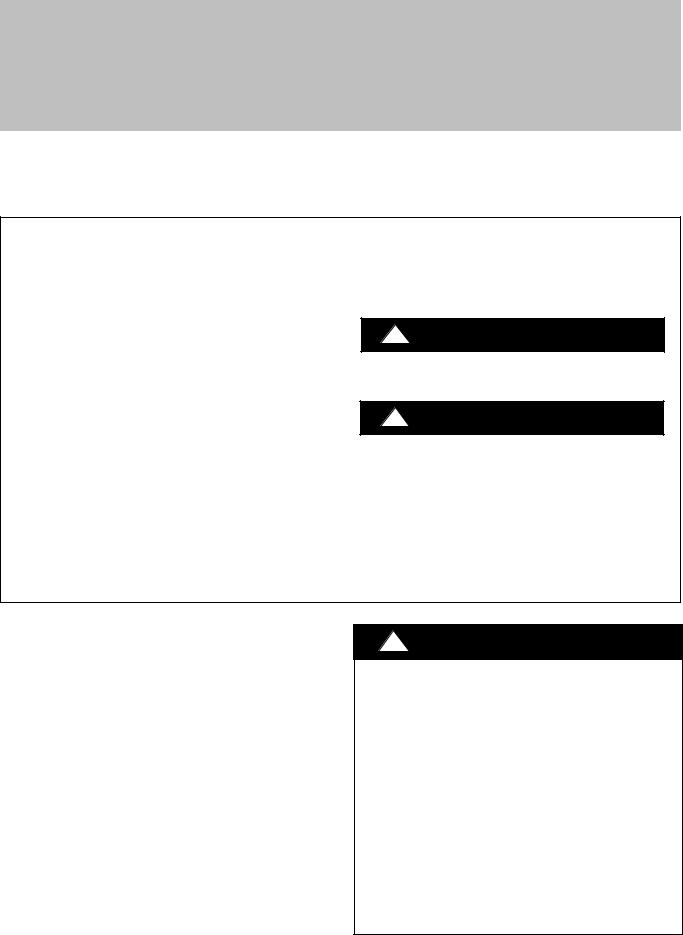
INSTALLATION INSTRUCTIONS
R−410A Split System Heat Pump
N4H3, C4H3, H4H3, T4H3,
N4H4, NXH5, CXH5, HXH5, TXH5
These instructions must be read and understood completely before attempting installation.
IMPORTANT: Effective January 1, 2015, all split system and packaged air conditioners must be installed pursuant to applicable regional efficiency standards issued by the Department of Energy.
Safety Labeling and Signal Words
DANGER, WARNING, CAUTION, and NOTE
The signal words DANGER, WARNING, CAUTION, and NOTE are used to identify levels of hazard seriousness. The signal word DANGER is only used on product labels to signify an immediate hazard. The signal words WARNING, CAUTION, and NOTE will be used on product labels and throughout this manual and other manuals that may apply to the product.
DANGER − Immediate hazards which will result in severe personal injury or death.
WARNING − Hazards or unsafe practices which could result in severe personal injury or death.
CAUTION − Hazards or unsafe practices which may result in minor personal injury or product or property damage.
NOTE − Used to highlight suggestions which will result in enhanced installation, reliability, or operation.
Signal Words in Manuals
The signal word WARNING is used throughout this manual in the following manner:
WARNING
! WARNING
The signal word CAUTION is used throughout this manual in the following manner:
!CAUTION
Signal Words on Product Labeling
Signal words are used in combination with colors and/or pictures on product labels.
TABLE OF CONTENTS
Inspect New Unit . . . . . . . . . . . . . . . . . . . . . . . . . . . . . . . 2
Safety Considerations . . . . . . . . . . . . . . . . . . . . . . . . . . . 2
Location . . . . . . . . . . . . . . . . . . . . . . . . . . . . . . . . . . . . . . . 2
Clearances . . . . . . . . . . . . . . . . . . . . . . . . . . . . . . . . . . . . 2
Unit Support . . . . . . . . . . . . . . . . . . . . . . . . . . . . . . . . . . . 2
Refrigeration System . . . . . . . . . . . . . . . . . . . . . . . . . . . 3
Electrical Wiring . . . . . . . . . . . . . . . . . . . . . . . . . . . . . . . . 7
Defrost System . . . . . . . . . . . . . . . . . . . . . . . . . . . . . . . . 9
Start−up Procedure . . . . . . . . . . . . . . . . . . . . . . . . . . . . 11
Refrigerant Charge . . . . . . . . . . . . . . . . . . . . . . . . . . . . 11
Sequence of Operation . . . . . . . . . . . . . . . . . . . . . . . . . 12
Troubleshooting . . . . . . . . . . . . . . . . . . . . . . . . . . . . . . . 16
Maintenance . . . . . . . . . . . . . . . . . . . . . . . . . . . . . . . . . . 16
Comfort Alertt Diagnostics Codes . . . . . . . . . . . . . . 17
R−410A Quick Reference Guide . . . . . . . . . . . . . . . . . 18
!WARNING
DEATH, PERSONAL INJURY, AND/OR PROPERTY DAMAGE HAZARD
Failure to carefully read and follow this warning could result in equipment malfunction, property damage, personal injury and/or death.
Installation or repairs made by unqualified persons could result in equipment malfunction, property damage, personal injury and/or death.
The information contained in this manual is intended for use by a qualified service technician familiar with safety procedures and equipped with the proper tools and test instruments.
Installation must conform with local building codes and with the National Electrical Code NFPA70 current edition or Canadian Electrical Code Part 1 CSA C.22.1.
428 01 5106 03 6/17/15
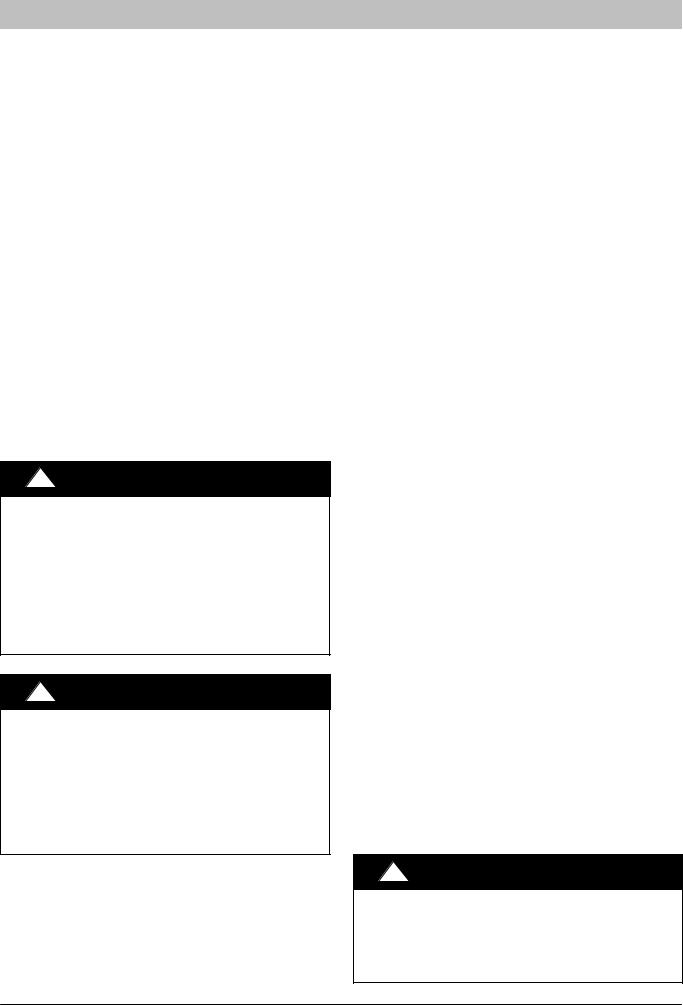
INSTALLATION INSTRUCTIONS
INSPECT NEW UNIT
After uncrating unit, inspect thoroughly for hidden damage. If damage is found, notify the transportation company immediately and file a concealed damage claim.
SAFETY CONSIDERATIONS
Consult a qualified installer, service agency, or the dealer/distributor for information and assistance. The qualified installer must use factory authorized kits and accessories when modifying this product. Refer to the individual instructions packaged with the kit or accessory when installing.
The weight of the product requires careful and proper handling procedures when lifting or moving to avoid personal injury. Use care to avoid contact with sharp or pointed edges.
Follow all safety codes. Wear safety glasses, protective clothing, and work gloves. Use a heat sinking material − such as a wet rag − during brazing operations. Keep a fire extinguisher available. Consult local codes and the National Electric Code (NEC) for special requirements.
Improper installation, adjustment, alteration, service or maintenance can void the warranty.
!WARNING
ELECTRICAL SHOCK HAZARD
Failure to turn off the main (remote) electrical disconnect device could result in personal injury or death.
Before installing, modifying or servicing system, turn OFF the main (remote) electrical disconnect device. There may be more than one disconnect device. Lock out and tag switch with a suitable warning label.
!CAUTION
PROPERTY DAMAGE HAZARD
Failure to follow this caution may result in property damage
R−410A systems operate at higher pressures than R−22 systems. When working with R−410A systems, use only service equipment and replacement components specifically rated or approved for R−410A service.
R−410A Split System Heat Pump
Locate unit in a well drained area, or support unit high enough so that water runoff will not enter the unit.
Locate unit away from areas where heat, lint, or exhaust fumes will be discharged onto unit (as from dryer vents).
Locate unit away from recessed or confined areas where recirculation of discharge air may occur (refer to CLEARANCES section of this document).
Roof−top installation is acceptable providing the roof will support the unit and provisions are made for water drainage and noise/vibration dampening.
NOTE: Roof mounted units exposed to wind may require wind baffles. Consult the manufacturer for additional information.
CLEARANCES
When installing, allow sufficient space for airflow clearance, wiring, refrigerant piping, and service. Allow 24 in. (610 mm) clearance to service end of unit and 48 in. (1219.2 mm) above unit. For proper airflow, a 6 in. (152.4 mm) clearance on one side of unit and 12 in. (304.8 mm) on all remaining sides must be maintained. Maintain a distance of 24 in. (609.6 mm) between units or 18 in. (457.2 mm) if no overhang within 12 ft. (3.66m). Position so water, snow, or ice from roof or eaves cannot fall directly on unit.
On rooftop applications, locate unit at least 6 in. (152.4mm) above roof surface.
UNIT SUPPORT
NOTE: Unit must be level " 2 degrees [3/8 inch rise or fall per foot of run (10mm rise or fall per 305 mm of run)] or compressor may not function properly.
A. GROUND LEVEL INSTALLATION
The unit must be level and supported above grade by beams, platform, or a pad. Platform or pad can be of open or solid construction but should be of permanent materials such as concrete, bricks, blocks, steel, or pressure− treated timbers approved for ground contact. Soil conditions must be considered so that the platform or pad does not shift or settle and leave the unit partially supported. Minimum pad dimensions are shown in Figure 1.
If beams or an open platform are used for support, it is recommended that the soil be treated or area be graveled to reduce the growth of grasses and weeds.
To minimize vibration or noise transmission, it is recommended that supports not be in contact with the building structure. However, slabs on grade constructions with an extended pad are normally acceptable.
LOCATION
Check local codes for regulations concerning zoning, noise, platforms, and other issues.
Locate unit away from fresh air intakes, vents, or bedroom windows. Noise may carry into the openings and disturb people inside.
!CAUTION
PROPERTY DAMAGE HAZARD
Failure to follow this caution may result in property damage.
Top surface of platform must be above estimated snowfall level to prevent snow blocking coil and to allow water melt to drain from unit.
2 |
Specifications subject to change without notice. |
428 01 5106 03 |
|

INSTALLATION INSTRUCTIONS
Figure 1 |
Tie Down Knockouts |
|
|
a” (10mm) dia. Tie Down Knockouts In Base Pan (2 places)
View From Top
Base
Pan
Depth
C
B |
A |
Base Pan Width |
Inches (mm)
Base Pan |
|
Tie Down |
Minimum |
|||
Knockouts |
Mounting Pad |
|||||
Width x Depth |
||||||
A |
|
B |
C |
Dimensions |
||
|
|
|||||
|
|
|
|
|
|
|
23 x 23 |
7−3/4 |
|
4−7/16 |
18 |
23 x 23 |
|
(584 x 584) |
(197) |
|
(113) |
(457) |
(584 x 584) |
|
|
|
|
|
|
|
|
25−11/16 x |
9−1/16 |
|
4−7/16 |
21−1/4 |
26 x 26 |
|
25−11/16 |
|
|||||
(230) |
|
(113) |
(540) |
(660 x 660) |
||
(652 x 652) |
|
|||||
|
|
|
|
|
||
|
|
|
|
|
|
|
31−1/8 x 31−1/8 |
9−1/16 |
|
6−1/2 |
24−5/8 |
31−1/2 x 31−1/2 |
|
(791 x 791) |
(230) |
|
(165) |
(625) |
(800 x 800) |
|
|
|
|
|
|
|
|
34−15/16 x |
9−1/16 |
|
6−1/2 |
28−7/16 |
35 x 35 |
|
34−15/16 |
|
|||||
(230) |
|
(165) |
(722) |
(889 x 889) |
||
(887 x 887) |
|
|||||
|
|
|
|
|
||
|
|
|
|
|
|
|
B. ROOF TOP INSTALLATION
This type of installation is not recommended on wood frame structures where low noise levels are required.
Supporting structure or platform for the unit must be level. If installation is on a flat roof, locate unit minimum 6 inches (152mm) above roof level.
Place the unit over one or more load bearing walls. If there are several units, mount them on platforms that are self−supporting and span several load bearing walls. These suggestions are to minimize noise and vibration transmission through the structure. If the structure is a home or apartment, avoid locating the unit over bedrooms or study.
NOTE: When unit is to be installed on a bonded guaranteed roof, a release must be obtained from the building owner to free the installer from all liabilities.
C. FASTENING UNIT DOWN
If conditions or local codes require the unit be attached in place, remove the knockouts in the base pan and install tie down bolts through the holes (refer to Figure 1).
Contact local distributor for hurricane hold−down details and the P.E. (Professional Engineer) certification, when required.
R−410A Split System Heat Pump
!CAUTION
PROPERTY DAMAGE HAZARD
Failure to follow this caution may result in property damage.
Inadequate unit support may cause excessive vibration, noise, and/or stress on the refrigerant lines, leading to refrigerant line failure.
REFRIGERATION SYSTEM
A. COMPONENT MATCHES
Check to see that the proper system components are in place, especially the indoor coil.
R−410A outdoor units can only be used with R−410A specific indoor coils. If there is a refrigerant mis−match, consult the indoor coil manufacturer to determine if a refrigerant conversion kit is available for the indoor coil.
This outdoor unit is designed to achieve maximum efficiency when used with indoor coils that utilize a TXV refrigerant metering device or Piston with Teflon ring metering device. If any other type of metering device is installed on the indoor coil, consult the indoor coil manufacturer to determine if a conversion kit is available.
Installing with TXV.
When installing a TXV on an indoor coil, follow the instructions provided with the new TXV.
A typical TXV installation is shown in Figure 2.
Figure 2 |
Typical TXV Installation |
|
|
INDOOR
COIL
EQUALIZER
TUBE
SENSING |
SUCTION |
BULB |
TUBE |
 LIQUID
LIQUID
TUBE
TXV
10 O’Clock
2 O’Clock
SENSING BULB



 STRAP
STRAP
 SUCTION TUBE 7/8 IN. OD & SMALLER
SUCTION TUBE 7/8 IN. OD & SMALLER
428 01 5106 03 |
Specifications subject to change without notice. |
3 |
|
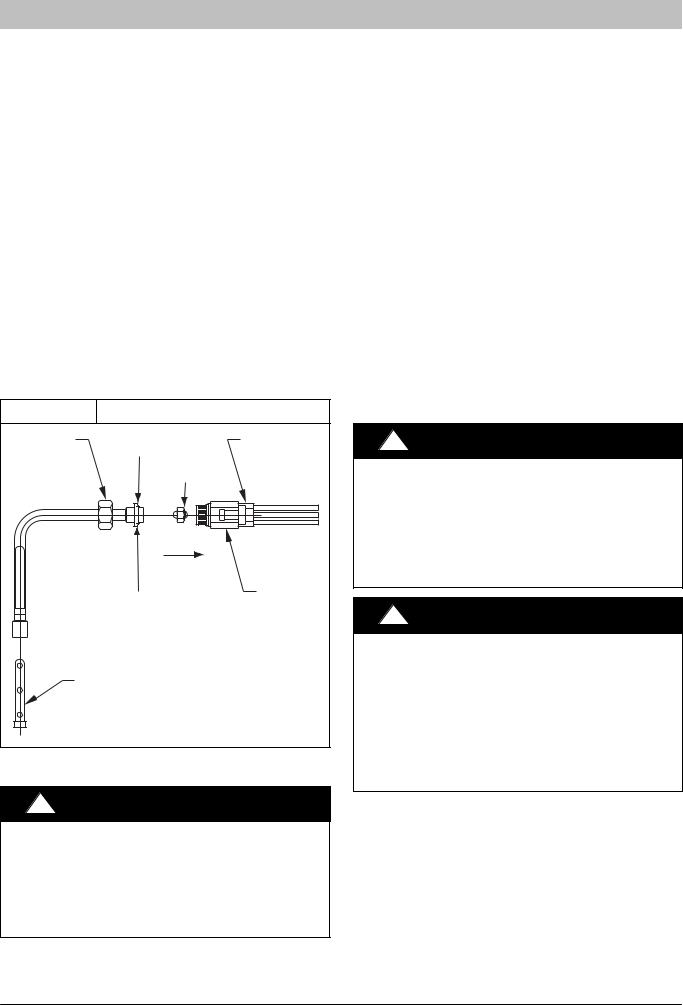
INSTALLATION INSTRUCTIONS
Installing with Indoor Piston − cooling operation.
(Heat pumps also use an outdoor piston for heating operation, refer to section F.)
Check piston size shipped with indoor unit to see if it matches required indoor piston size shown on outdoor unit rating plate.
If it does not match, replace indoor piston with cooling piston, according to size marked on outdoor unit rating plate. (Some outdoor models include a cooling piston in the accessory bag.)
Heating piston is shipped in the service valve − refer to section F.
Example fan coils with piston: FEM4P, FSM4P, FSU4P, FMA4P, FMC4P, FMU4P.
See Figure 3.
When changing indoor piston, use a back−up wrench. Finger tighten hex nut, then tighten with wrench 1/2 turn. Do not exceed 30 ft−lbs (40.7 N−m).The indoor piston contains a Teflon ring (or seal) which is used to seat against the inside of distributor body, and must be installed properly to ensure proper seating in the direction for cooling operation.
Figure 3 |
Indoor (cooling) Piston |
|
BRASS |
|
DISTRIBUTOR |
HEX NUT |
TEFLON SEAL |
|
|
TEFLON RING |
|
|
PISTON |
|
|
FLOW IN |
|
|
COOLING |
|
|
PISTON |
BRASS |
|
HEX BODY |
|
|
RETAINER |
|
|
|
|
|
STRAINER |
|
|
|
L10S017 |
! |
CAUTION |
|
PRODUCT OPERATION HAZARD
Failure to follow this caution may result in improper product operation.
If using a TXV in conjunction with a single−phase reciprocating compressor, a compressor start capacitor and relay are required. Consult outdoor unit pre−sale literature for start assist kit part number.
B. REFRIGERANT LINE SETS
The refrigerant line set must be properly sized to assure maximum efficiency and proper oil circulation.
R−410A Split System Heat Pump
Refer to Product Specifications and Long Line Applications Guideline for line set sizing.
NOTE: Total line set length must not exceed 200 feet (61m).
NOTE: A crankcase heater must be used when the refrigerant line length exceeds 80 feet (24.4m).
If outdoor unit is more than 10 feet (3m) higher than the indoor coil, refer to the Long Line Applications Guideline for instructions.
NOTE: When the outdoor unit is higher than the indoor coil, the vertical separation must not exceed 100 feet (30m).
NOTE: When the outdoor unit is lower than the indoor coil, the vertical separation must not exceed 50 feet (15.2m).
If it is necessary to add refrigerant line in the field, use dehydrated or dry, sealed, deoxidized, copper refrigeration tubing. Do not use copper water pipe.
Do not remove rubber plugs or caps from copper tubing until connections are ready to be made.
Be extra careful when bending refrigeration tubing. Tubing can “kink” easily, and if this occurs, the entire length of tubing must be replaced.
!WARNING
PERSONAL INJURY HAZARD
Failure to relieve system pressure could result in personal injury and/or death.
Relieve pressure and recover all refrigerant before servicing existing equipment, and before final unit disposal. Use all service ports and open all flow− control devices, including solenoid valves.
!CAUTION
UNIT OPERATION HAZARD
Failure to follow this caution may result in improper product operation.
Do not leave system open to atmosphere any longer than absolutely required for installation. Internal system components − especially refrigerant oils − are extremely susceptible to moisture contamination. Keep ends of tubing sealed during installation until the last possible moment.
C.ROUTING AND SUSPENDING REFRIGERANT LINES
Run refrigerant lines as straight and direct as possible, avoiding unnecessary bends and turns. Always insulate the entire suction line. Both lines should be insulated when routed through an attic or when routed through an underground raceway.
When routing refrigerant lines through a foundation or wall, do not allow refrigerant lines to come in direct contact with the building structure. Make openings large enough so that lines can be wrapped with extra insulation. Fill all gaps with RTV caulk. This will prevent noise
4 |
Specifications subject to change without notice. |
428 01 5106 03 |
|
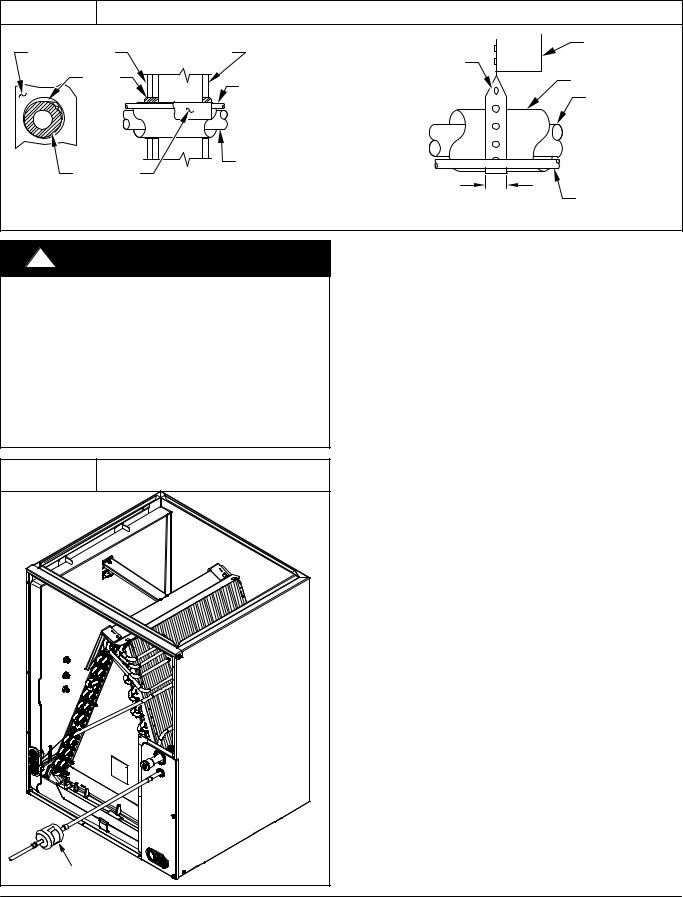
INSTALLATION INSTRUCTIONS |
R−410A Split System Heat Pump |
|
|
transmission between the tubing and the foundation or wall.
Along floor or ceiling joists, suspend refrigerant lines so that they do not contact the building structure, water
pipes, or ductwork. Use insulated or suspension type hangers. Metal straps must be at least 1” (25mm)wide to avoid cutting into the tube insulation. Keep the liquid and suction lines separate. Refer to Figure 4.
Figure 4 |
|
Routing and Suspending Refrigerant Lines |
|
|
OUTDOOR WALL |
INDOOR WALL |
|
|
JOIST |
|
HANGER STRAP |
|
||
|
|
|
|
|
CAULK |
|
|
(AROUND SUCTION |
INSULATION |
|
LIQUID TUBE |
TUBE ONLY) |
||
|
|
SUCTION TUBE |
||
|
|
|
|
|
|
|
SUCTION TUBE |
|
|
INSULATION |
|
|
|
|
|
|
|
1” (25mm) MIN |
LIQUID TUBE |
|
|
|
|
|
|
THROUGH THE WALL |
|
SUSPENSION |
|
!CAUTION
UNIT OPERATION HAZARD
Failure to follow this caution may result in improper product operation.
Do not bury more than 36” (1m) of line set underground. Refrigerant may migrate to cooler buried section during extended periods of unit shut− down, causing refrigerant slugging and possible compressor damage at start−up.
If ANY section of the line set is buried underground, provide a minimum 6” (152mm) vertical rise at the service valve.
Figure 5 |
Liquid Line Filter−Drier |
|
Installed at Indoor Coil |
||
|
||
Filter−Drier |
38−11−84 |
D. OUTDOOR UNIT HIGHER THAN INDOOR UNIT
Proper oil return to the compressor should be maintained with suction gas velocity. If velocities drop below 1500 fpm (feet per minute), oil return will be decreased. To maintain suction gas velocity, do not upsize vertical suction risers.
E. LIQUID LINE FILTER−DRIER
Outdoor units are shipped with an appropriate filter−drier for installation in the liquid line. Leave the plugs in the tube ends until the filter−drier is installed. The optimal location for the filter−drier is close to the indoor coil. Heat pump filter−driers are “bi−flow” type. Either end can be pointed towards indoor coil. Refer to Figure 5.
F. SERVICE VALVES
Service valves are closed and plugged from the factory. Outdoor units are shipped with a refrigerant charge sealed in the unit. Leave the service valves closed until all other refrigerant system work is complete or the charge will be lost. Leave the plugs in place until line set tubing is ready to be inserted.
Heat pumps require a piston metering device in the liquid service valve for proper heating operation. Piston is shipped in the piston body of the liquid service valve, temporarily held in place with a plastic cap. Do not remove the plastic cap until line set tubing is ready to be installed.
Refer to Figure 6 and follow these steps for piston installation:
1.Remove plastic cap holding piston in piston body of liquid service valve.
2.Check that piston size (stamped on side of piston) matches with number listed on unit rating plate. Return piston to piston body of liquid service valve (either direction).
3.Find plastic bag taped to unit containing copper adapter tube, brass nut, and plastic washer.
4.Install plastic washer in the seat inside piston body.
5.Fit brass nut onto adapter tube and install tube onto liquid service valve. Tighten nut finger tight, then wrench additional ½ turn only [15−ft lbs (20.3 N−m)]. Over tightening may damage the plastic washer.
428 01 5106 03 |
Specifications subject to change without notice. |
5 |
|
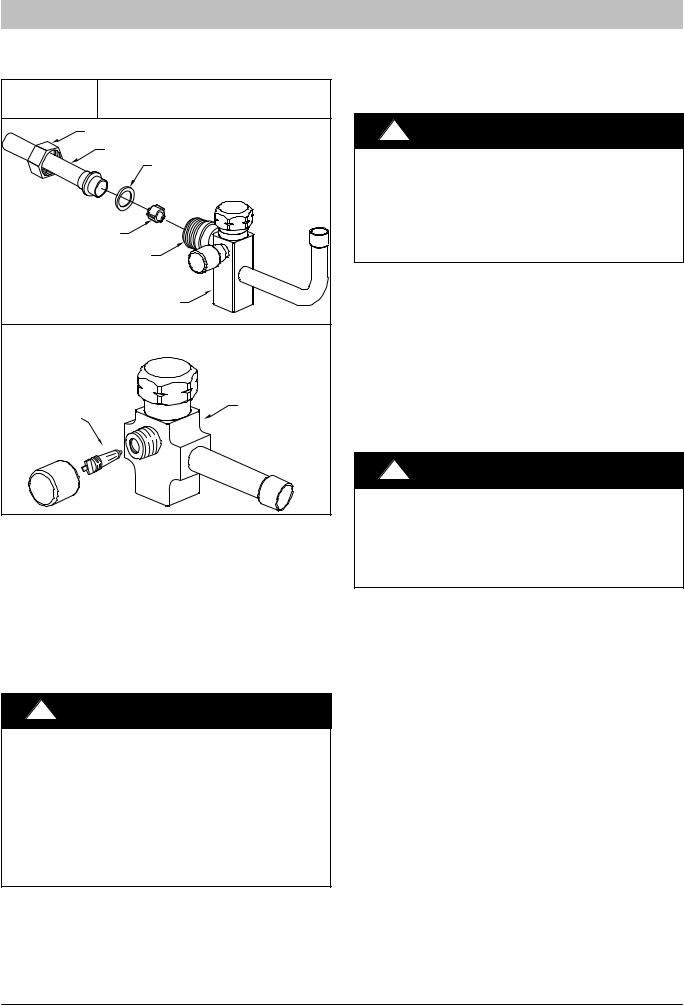
INSTALLATION INSTRUCTIONS
Service valve bodies are brass and suction tube stub is copper.
Figure 6 |
Liquid Service Valve with Heating |
|
Piston and Adapter Tube |
||
|
||
|
BRASS NUT |
|
|
ADAPTER TUBE |
|
|
PLASTIC WASHER |
|
PISTON |
||
PISTON BODY |
||
LIQUID SERVICE VALVE |
||
|
Vapor Service Valve |
|
|
SERVICE VALVE |
|
VALVE CORE |
|
|
G. BRAZING CONNECTIONS NOTE:
For Liquid Service Valve − Braze lineset to adapter tube BEFORE bolting adapter to valve. This helps prevent overheating and damage to plastic washer or o−ring.
For Vapor Service Valve − remove valve core from schrader port on Service Valve BEFORE brazing. This helps prevent overheating and damage to valve seals (refer to Figure 6). Replace valve core when brazing is completed.
!WARNING
FIRE HAZARD
Failure to remove refrigerant and oil charge before brazing could result in personal injury, death, and/ or property damage.
Refrigerant and oil mixture could ignite and burn as it escapes and contacts brazing torch. Make sure the refrigerant charge is properly removed from both the high and low sides of the system before brazing any component or lines.
Clean line set tube ends with emery cloth or steel brush. Remove any grit or debris.
Insert line set tube ends into service valve tube stubs.
R−410A Split System Heat Pump
Apply heat absorbing paste or heat sink product between service valve and joint. Wrap service valves with a heat sinking material such as a wet cloth.
Braze joints using a Sil−Fos or Phos−copper alloy.
!CAUTION
PRODUCT DAMAGE HAZARD
Failure to follow this caution may result in product damage.
Braze with Sil−Fos or Phos−copper alloy on copper−to−copper joints and wrap a wet cloth around rear of fitting to prevent damage to TXV.
H. EVACUATING LINE SET AND INDOOR COIL
The unit is shipped with a factory refrigerant charge. The liquid line and suction line service valves have been closed after final testing at the factory. Do not disturb these valves until the line set and indoor coil have been evacuated and leak checked, or the charge in the unit may be lost.
NOTE: Do not use any portion of the factory charge for purging or leak testing. The factory charge is for filling the system only after a complete evacuation and leak check has been performed.
!CAUTION
PRODUCT DAMAGE HAZARD
Failure to follow this caution may result in product damage.
Never use the outdoor unit compressor as a vacuum pump. Doing so may damage the compressor.
Line set and indoor coil should be evacuated using the recommended deep vacuum method of 500 microns. If deep vacuum equipment is not available, the alternate triple evacuation method may be used by following the specified procedure.
If vacuum must be interrupted during the evacuation procedure, always break vacuum with dry nitrogen.
Deep Vacuum Method
The deep vacuum method requires a vacuum pump capable of pulling a vacuum to 500 microns and a vacuum gauge capable of accurately measuring this vacuum level. The deep vacuum method is the most positive way of assuring a system is free of air and water.
Watch the vacuum gauge as the system is pulling down. The response of the gauge is an indicator of the condition of the system (refer to Figure 7).
With no leaks in the system, allow the vacuum pump to run for 30 minutes minimum at the deep vacuum level.
6 |
Specifications subject to change without notice. |
428 01 5106 03 |
|
